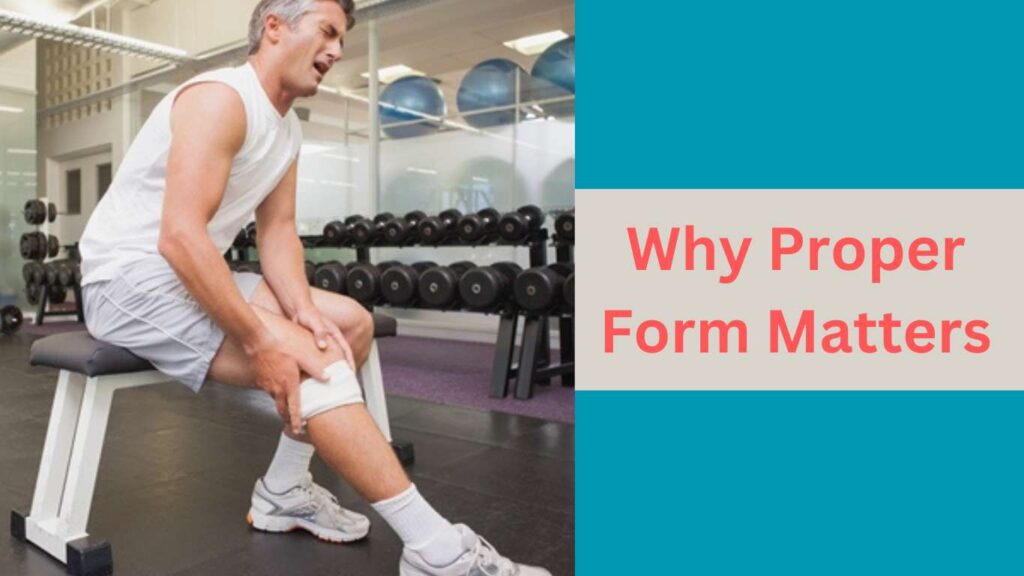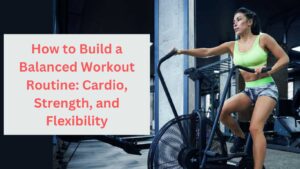When starting your fitness journey, proper form is critical for achieving your goals safely and effectively. Using correct technique during exercises not only maximizes results but also minimizes the risk of injury. In this guide, we’ll break down the importance of form, common mistakes to avoid, and a beginner-friendly workout and diet plan that promotes safety and progress.
Why Proper Form Matters

1. Injury Prevention
The number one reason to focus on proper form is to prevent injuries. Incorrect form can place undue stress on your joints, muscles, and ligaments, increasing the risk of strains, sprains, and even serious injuries like torn ligaments or herniated discs. For example, improper squat form can lead to knee pain, while incorrect posture during push-ups can strain your shoulders.
2. Maximizing Effectiveness
Correct form ensures that you’re using the intended muscles during each exercise. This leads to better and faster results. For instance, performing a push-up with proper form targets your chest, shoulders, and triceps. But if you let your hips sag or round your back, you might not engage those muscles fully, leading to less effective training.
3. Long-Term Progress
Using correct form from the start helps establish proper movement patterns. Over time, your muscles and joints will become accustomed to these patterns, making it easier to progress as you increase weights or try more challenging exercises. Starting with good habits also means you’re less likely to develop bad habits that could hinder your progress.
How to Maintain Proper Form in Exercises
1. Squats
Common Mistakes:
- Knees caving inward.
- Leaning too far forward.
- Not keeping a straight back.
Proper Form:
- Feet: Place your feet shoulder-width apart, with toes pointing slightly outward.
- Movement: Push your hips back as if you’re sitting in a chair, keeping your chest lifted and your back neutral.
- Knees: Make sure your knees track over your toes, not collapsing inward.
- Depth: Lower your body until your thighs are parallel to the ground (or slightly deeper if comfortable).
- Core: Engage your core to protect your lower back throughout the movement.
Tip: If you’re a beginner, practice squats in front of a mirror or with a chair behind you. Sit down gently on the chair before standing back up to ensure you’re using proper form.
2. Push-Ups
Common Mistakes:
- Hips sagging or raised too high.
- Hands placed too wide or too narrow.
- Rounding the back during the movement.
Proper Form:
- Hands: Position your hands slightly wider than shoulder-width apart with fingers spread.
- Body Alignment: Keep your body in a straight line from head to heels, engaging your core to avoid sagging hips.
- Elbows: Bend your elbows at a 45-degree angle as you lower your body.
- Movement: Lower your chest until it’s just above the ground, then press back up with control.
Tip: If you’re unable to do a full push-up, modify by performing them on your knees or against a wall until you build more strength.
3. Deadlifts
Common Mistakes:
- Rounding the back.
- Pulling with the arms instead of the legs.
- Lifting too heavy too soon.
Proper Form:
- Foot Placement: Stand with your feet hip-width apart, and the barbell (or dumbbells) over the middle of your feet.
- Grip: Bend at your hips and knees, keeping a neutral spine. Grip the barbell with your hands just outside your knees.
- Back: Maintain a straight back—engage your core to prevent rounding your lower back.
- Movement: Push through your heels, driving your hips forward to lift the bar, keeping it close to your body. Lower the bar in a controlled manner, maintaining the straight back.
Tip: Start with lighter weights to practice your form. Focus on hinging from the hips, not bending at the waist.
4. Planks
Common Mistakes:
- Hips sagging too low.
- Neck strained by looking forward.
- Core not engaged.
Proper Form:
- Elbow Placement: Position your elbows directly under your shoulders.
- Body Alignment: Keep your body in a straight line from head to heels.
- Core Engagement: Engage your core by pulling your belly button toward your spine. This will prevent your hips from sagging.
- Neck: Keep your head aligned with your spine, looking straight down or at a small spot on the floor.
Tip: Start by holding a plank for 20-30 seconds, gradually increasing as your core strength improves.
Beginner Home Workout Plan
This workout plan is designed to help you learn and practice proper form while building strength. Perform these exercises 3-4 days a week for the best results.
Warm-Up (5-10 minutes):
- Jumping jacks (1 minute)
- Arm circles (1 minute)
- Leg swings (1 minute)
- Bodyweight squats (2 sets of 10-15)
Workout:
1. Bodyweight Squats
- Sets: 3
- Reps: 12-15
- Focus on form: Keep your chest up, knees over toes, and back neutral.
2. Push-Ups (Modify if needed)
- Sets: 3
- Reps: 8-12 (or as many as you can with good form)
- Focus on form: Keep your body straight, elbows at 45-degree angles.
3. Glute Bridges
- Sets: 3
- Reps: 12-15
- Focus on form: Squeeze your glutes at the top and avoid arching your back.
4. Planks
- Sets: 3
- Hold: 20-30 seconds
- Focus on form: Keep your body in a straight line from head to heels, core engaged.
5. Superman Holds
- Sets: 3
- Hold: 20-30 seconds
- Focus on form: Lift your chest and legs off the floor while keeping your arms extended forward.
Cool Down (5 minutes):
- Stretch your hamstrings, quads, and back. Hold each stretch for 20-30 seconds.
Beginner Diet Plan
Your nutrition plays a vital role in supporting your fitness progress. A balanced diet will provide the energy needed for workouts, promote muscle recovery, and help you maintain a healthy weight.
General Tips:
- Eat a balance of protein, carbs, and fats in each meal.
- Drink plenty of water throughout the day (aim for at least 8 glasses).
- Focus on whole, nutrient-dense foods like vegetables, fruits, lean proteins, and whole grains.
Sample Diet Plan:
Breakfast:
- Scrambled eggs with spinach (2 eggs + handful of spinach)
- 1 slice of whole grain toast
- 1/2 avocado
- 1 cup of black coffee or green tea
Snack (Mid-Morning):
- Greek yogurt (unsweetened) with a handful of mixed berries
- A small handful of almonds
Lunch:
- Grilled chicken breast or tofu
- Quinoa or brown rice
- Mixed salad (spinach, kale, cucumber, olive oil, and lemon dressing)
Snack (Mid-Afternoon):
- Apple or banana
- A boiled egg or string cheese
Dinner:
- Baked salmon or grilled chicken
- Sweet potatoes (roasted or mashed)
- Steamed broccoli or green beans
Optional Evening Snack:
- Carrot sticks with hummus or a protein smoothie (protein powder, almond milk, banana).
Track Progress and Stay Consistent
Consistency is key to seeing progress. Track your workouts and meals to ensure you’re following the plan and making improvements. Here are some ways to track your progress:
- Workout Log: Write down the number of sets, reps, and weights used for each exercise.
- Measurements: Track your body measurements (waist, hips, arms) every 2-3 weeks to see physical changes.
- How You Feel: Record how your body feels after each workout. Are you improving in strength or endurance?
Conclusion
Prioritizing proper form in your workouts is essential for long-term success and injury prevention. With this beginner-friendly workout and diet plan, you can build a strong foundation for your fitness journey. Take your time to master each movement, stay consistent, and adjust as you progress. Over time, proper form will become second nature, helping you achieve your goals safely and effectively.




